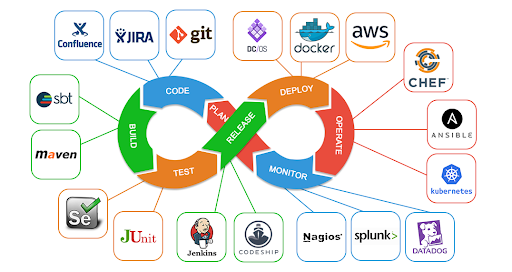In the realm of IT, companies often grapple with prolonged release cycles, diminished team productivity, and issues pertaining to the quality and reliability of software. These enterprise challenges can impede progress and hinder competitiveness. DevOps solutions address these chronic issues by integrating development, testing, and operations and, thus, optimizing timing. Let’s find out in this article what specific issues DevOps can address and how to resolve them.

The Core Objectives of DevOps and SRE
The core DevOps objectivesinclude fostering collaboration between development and operations teams, automating processes for efficiency, ensuring continuous integration and delivery, and enhancing overall software delivery speed and reliability. On the other hand, there is also site reliability engineering (SRE), which often goes alongside DevOps. DevOps and SRE share core objectives that align with achieving optimal business outcomes.
Historically, development and delivery processes operated independently, with developers coding, testers verifying, and deployment teams handling application deployment and infrastructure configuration. This siloed approach led to various challenges. However, DevOps along with SRE practices aim to address these issues. Next, we will delve into more detail about each of these approaches.
What is DevOps?
DevOps is a cultural and collaborative approach to software development and IT operations, emphasizing communication, integration, and automation to streamline the entire software delivery process for enhanced efficiency and agility.
There is also the concept of SRE, which complements DevOps practices. Now, let’s delve into the DevOps vs. SRE distinctions. Understanding the differences between DevOps and SRE is necessary to apply the appropriate principles and practices to meet reliability goals and business objectives.
What is site reliability engineering?
While DevOps primarily represents a broad cultural shift in development and operations with efficient delivery, SRE introduces specific technical practices focused on the stability, scalability and reliability of production systems.
SRE is a discipline that combines software engineering and systems administration to enhance the reliability and performance of large-scale, complex systems. SREs automate operations, optimize systems, and ensure a seamless user experience.
The Importance of Collaboration Between Development and Operations
Collaboration between development and operations is vital. Working closely with operations experts, developers gain insights into real-world constraints, enhancing system design. The ops team can influence architecture early, streamlining deployment. By combining human and technical resources, DevOps effectively addresses a range of challenges, solving existing issues and tackling subsequent problems.
Accelerating Production Cycles
Optimizing production cycles is pivotal for businesses aiming to shorten time to market and maintain a competitive edge. Streamlining the development and delivery processes and avoiding silos accelerates release frequency. Efficient synchronization of these aspects is paramount for swift and successful product launches, ensuring a strategic advantage for businesses.
Bringing Value to Customers with Faster Production Cycles
Revolutionizing software development, DevOps shifts from the traditional focus on delivering a flawless product in one go, which takes a lot of time. While embracing DevOps and SRE methodologies, you can prioritize frequent, minor updates, enabling weekly, daily, or hourly rapid releases — thanks to continuous integration and deployment. Let’s learn more about these practices.
How Continuous Integration and Continuous Deployment Help
CI and CD form the backbone of DevOps, molding the CI/CD pipeline. They facilitate rapid integration of developers’ changes, cutting release times from months to hours. This not only boosts software quality but also minimizes risks through incremental integration, ensuring a seamless development process.

Enhancing Productivity and Customer Satisfaction
DevOps principles, notably automation, revolutionize team productivity by streamlining routine tasks. An example could be the above-mentioned CI/CD practices, specifically the automated process of building, testing, and deploying software code whenever changes are made to the repository.
Identifying automation tasks is crucial, freeing the development and operations team to focus on critical functions directly impacting customer satisfaction. Examples include enhancing system stability, reducing failure risks, and accelerating development. Stable systems and rapid improvements contribute to reliable and efficient product performance and greater user satisfaction.
Cost-Efficiency Through DevOps
Leveraging DevOps practices not only results in streamlined operations and accelerated delivery but also unlocks significant cost-efficiency, ultimately leading to noteworthy DevOps cost savings.
Saving Costs Through Faster Time to Market
To enhance earnings, prioritize accelerating time to markets. Implementing user-requested features and innovation tools allows for quicker monetization, gaining a competitive edge. Responsive market adaptation strengthens brand loyalty, fostering sustained revenue growth.
Optimization of Resource Allocation
Streamlining resource allocation not only enhances efficiency but also aligns with sustainable practices. This approach, such as employing cloud solutions, not only optimizes costs but contributes to a more environmentally friendly and adaptable infrastructure. Consider a data storage scenario where cloud providers offer various storage classes. For instance, AWS provides options like Standard, Intelligent-Tiering, Glacier, etc.
Ensuring Software Quality
Ensuring software quality is paramount. This involves employing test automation, monitoring, and logging. Enhanced quality through these practices ensures robust and reliable software, a crucial aspect in today’s digital world.
Enhanced Quality with Test Automation
As previously mentioned, one of the critical principles of DevOps is automating everything possible, and test automation is no exception. Let’s explore three types of testing to identify effective testing automation strategies, improve code quality, and ensure a fast and reliable development cycle within the principles of DevOps.:
- Unit testing validates individual code units (functions/methods) for correctness, aiding early bug detection and maintaining stability during code changes.
- Integration testing ensures correct interaction among program components, detects system-level issues, and confirms proper integration according to specifications.
- Regression testing verifies that code changes do not break existing functionality, preventing regression and maintaining program stability during modifications or expansions.
Monitoring and Logging
Monitoring and logging are essential DevOps practices that control software quality. They provide real-time insights into system performance, identify issues promptly, and enable proactive problem-solving, ensuring robust and reliable software

Troubleshooting and Problem Resolution
Before the adoption of DevOps practices, troubleshooting and problem-resolution processes in IT were often prolonged and inefficient. Weak communication between teams complicated collaborative issue resolution. DevOps practices address these challenges by enhancing troubleshooting and problem resolution by implementing DevOps automation services, fostering efficient and streamlined collaboration among teams.
Improving Problem Resolution with Incident Management
Effective incident management lies at the heart of DevOps principles, underscoring strategic approaches to resolving issues.
- Prioritization. DevOps emphasizes the importance of prioritizing incidents based on their impact on both the business and clients.
- Rapid escalation. Critical incidents are swiftly escalated using configured notification systems to ensure a prompt response.
- Collaboration across disciplines. It encourages cooperation among specialists from various fields, including development, testing, databases, and networks, to comprehensively analyze the issue.
- Thorough documentation. Maintain comprehensive logs and documentation timely throughout the incident resolution process to facilitate transparency and knowledge sharing.
- Sustained communication. Establish continuous communication with stakeholders, offering regular updates on the status and progress of an incident solution.
- Innovation in resolution. Encourage innovative approaches to problem-solving, introducing creative elements to the resolution process for enhanced efficiency.
Post-Mortem Analyses and Continuous Improvement
Examining incidents post-mortem and continuous improvement represent proactive strategies for managing incidents. Post-mortem involves reflecting on errors, while continuous improvement centers on ongoing enhancements for improved outcomes and processes.
Conclusion
DevOps addresses challenges such as inefficient collaboration, slow release cycles, and system instability. It enhances communication, automates processes, and promotes continuous integration, effectively solving these issues and improving software development and delivery. DevOps, exemplified by Sigma Software, presents a transformative approach to address critical challenges in software development and IT operations.
Interesting Related Article: “Integrating DevOps with Banking Conversational AI Solution“









